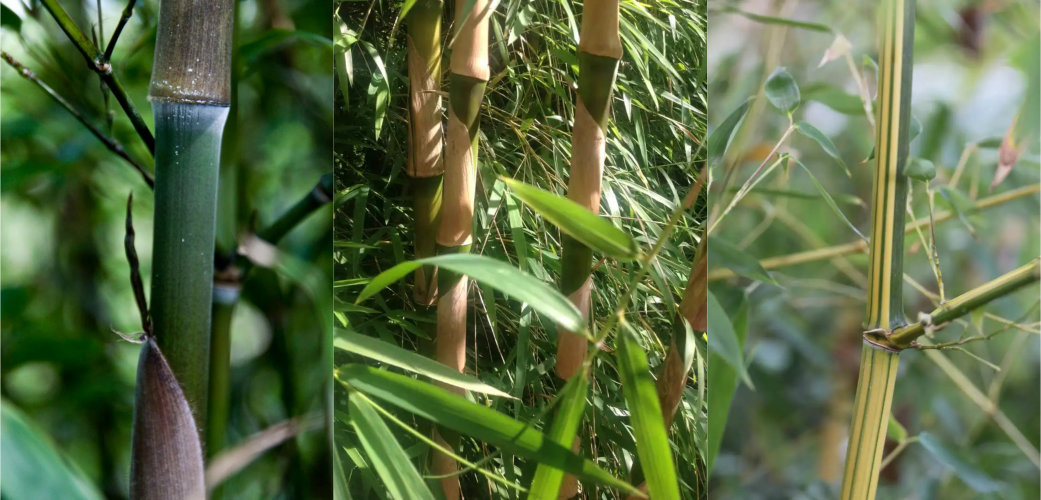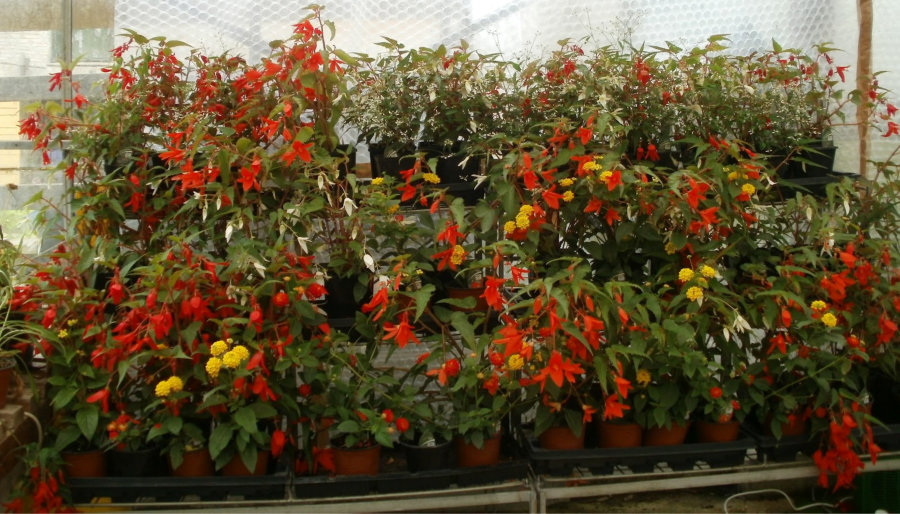Near the Lincolnshire town of Market Deeping is a nursery and garden filled with exotic and unusual plants, much to Roy’s delight.
Several years ago, on concluding a lecture in Welwyn Garden City, I was approached by a man carrying a plant of Zantedeschia ‘Hercules’ which he presented to me as a gift. His name was Colin Ward and he invited me to visit his nursery to see the many other plants he was growing. I did so, albeit somewhat belatedly, in June last year and I was not disappointed. Swinesmeadow Farm Nursery lies in Lincolnshire, in fenland landscape near the small market town of Market Deeping, and comprises a number of polytunnels, glasshouses and other structures clustered around an old farmhouse where Colin and his wife Karan live.
In addition, there is what Colin has christened ‘The Jungle’: a woodland garden where a rich selection of shrubs and perennials flourish. Many of these have bold foliage which, together with a scattering of hardy bamboos, help remind Colin of childhood years spent with his parents (his father worked as a teacher) in Hong Kong in the late 1960s.
‘Many’s the time I found relief from hot, humid weather by retreating to the relative cool tranquillity of a giant bamboo thicket,’ Colin says. It was in The Jungle therefore that we began our tour, where indeed several bamboos help to provide shelter. Colin pointed out Chusquea gigantea AGM, a big, powerful species with some culms (canes) already up to 8m (25ft) and 10cm (4in) in diameter in their lower part.
Following a Hosta trail
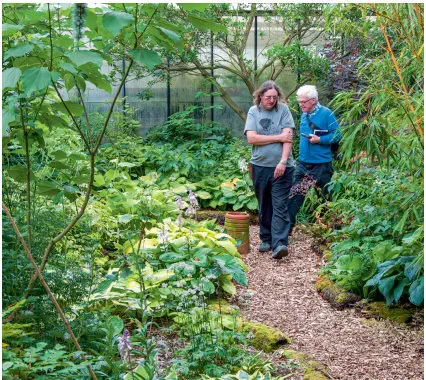 We followed an informal woodchip path, stopping at intervals to examine the rich planting of the ‘jungle’ floor, which was moist enough to support generous groups of Hosta. Among those which caught my eye were ‘High Noon’, with rich yellow, long-stalked, cordate, boldly veined and abruptly pointed leaves, and lower-growing ‘Sea Gulf Stream’ with shorter-stalked, golden, deeply veined and wavy-margined, well-textured leaves.
We followed an informal woodchip path, stopping at intervals to examine the rich planting of the ‘jungle’ floor, which was moist enough to support generous groups of Hosta. Among those which caught my eye were ‘High Noon’, with rich yellow, long-stalked, cordate, boldly veined and abruptly pointed leaves, and lower-growing ‘Sea Gulf Stream’ with shorter-stalked, golden, deeply veined and wavy-margined, well-textured leaves.
Elsewhere there was ‘Sea Grotto’ with rounded, almost dish-shaped and puckered leaves of a bloomy blue, darkening with age. Its flowers, Colin told me, are almost white and fragrant. Next to it was intriguingly named (aren’t they all?) ‘Komodo Dragon’, a big plant with larger, longer, more pointed leaves of blue-grey colour, likewise strongly veined.
At the beginning of the trail I was interested to note Aconitum lycoctonum ‘Russian Yellow’, a new name to me, which had tall (to 1.7m/5½ft), rigidly branching stems carrying crowded racemes of charming drooping, slender-helmeted, pale yellow flowers. It looked to be an improvement on the commonly grown form and I wasn’t surprised to hear that it had been originally collected, and presumably named, by the late nurseryman Michael Wickenden. Colin is particularly fond of Stachyurus chinensis ‘Joy Forever’, an AGM shrub of spreading habit with arching branches. Its typically slender, drooping spikes of pale yellow flowers in late winter are followed in spring by attractively variegated leaves – these are initially margined pale green, gradually changing to creamy white and finally yellow, the last two phases present together for a while on the same branch, making a pleasing combination. Close to the track I spotted blue-flowered Impatiens arguta growing with yellow Saruma henryi – another pretty combination that I have long enjoyed in my own garden.
Treats in the polytunnel
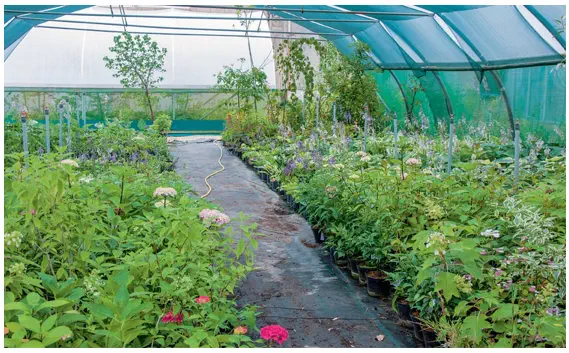 I could happily have spent the rest of the morning discussing the plant treasures in The Jungle but I was anxious to see those young plants growing in the cool glasshouse, polytunnels and on the well- stocked sales benches. Here we were joined by Marcus Grey, Colin’s capable assistant who handles much of the propagation. First to catch my attention was a batch of Cautleya cathcartii ‘Tenzing’s Gold’, a hardy member of the ginger family (Zingiberaceae) with handsome foliage and late-summer to autumn spikes of deep yellow flowers emerging from red sheaths, a
I could happily have spent the rest of the morning discussing the plant treasures in The Jungle but I was anxious to see those young plants growing in the cool glasshouse, polytunnels and on the well- stocked sales benches. Here we were joined by Marcus Grey, Colin’s capable assistant who handles much of the propagation. First to catch my attention was a batch of Cautleya cathcartii ‘Tenzing’s Gold’, a hardy member of the ginger family (Zingiberaceae) with handsome foliage and late-summer to autumn spikes of deep yellow flowers emerging from red sheaths, a
striking combination.
This handsome herbaceous perennial is related to the better-known Cautleya spicata I first saw (the species, that is) with fellow members of the University of Bangor Expedition in autumn 1971 to eastern Nepal, where it was commonly found crowning damp, mossy rocks in shade.
Totally different was Dietes bicolor, a member of the iris family (Iridaceae) from sunny South Africa, clump-forming but with underground rhizomes and erect fans of narrow, iris-like leaves. The flowers have six spreading segments which can vary in colour from pale yellow to white, normally with a dark stain at the base of the three larger outer segments. It requires a sunny, well-drained site but, for those in colder areas, it is suitable for a cool greenhouse or conservatory.
Surprising gunnera
 I was particularly delighted also to see Gunnera perpensa, which Colin was growing in a large tub with many smaller saleable plants in pots. This is the species, native to southern and tropical eastern Africa, on which Linnaeus based the genus and is rarely seen – unlike well-known, giant-leaved G. manicata and G. tinctoria, which are native to South America. By contrast, G. perpensa produces much smaller leaves on stalks up to 60cm (2ft) long. The leaf blades are kidney-shaped or rounded, with toothed and wavy margins, and are a dull, almost grey shade of green. The tiny green flowers are borne in dense spikes along an erect cylindrical panicle rising well above the leaves in summer. In warm gardens it can be grown outdoors when planted in muddy pond margins. I grow it in a large pot on our patio, consigning it to a sheltered place when the leaves die. In a container it demands constant moisture, wilting if left unwatered in a hot summer sun.
I was particularly delighted also to see Gunnera perpensa, which Colin was growing in a large tub with many smaller saleable plants in pots. This is the species, native to southern and tropical eastern Africa, on which Linnaeus based the genus and is rarely seen – unlike well-known, giant-leaved G. manicata and G. tinctoria, which are native to South America. By contrast, G. perpensa produces much smaller leaves on stalks up to 60cm (2ft) long. The leaf blades are kidney-shaped or rounded, with toothed and wavy margins, and are a dull, almost grey shade of green. The tiny green flowers are borne in dense spikes along an erect cylindrical panicle rising well above the leaves in summer. In warm gardens it can be grown outdoors when planted in muddy pond margins. I grow it in a large pot on our patio, consigning it to a sheltered place when the leaves die. In a container it demands constant moisture, wilting if left unwatered in a hot summer sun.
In praise of begonias and ferns
Over the next couple of hours Colin and I wandered from one area to another stopping frequently to discuss first one then another plant, including Begonia pedatifida and B. emeiensis, both of which I have seen in sheltered gardens, notably Abbotsbury Subtropical Gardens in Dorset. We then came upon a batch of Woodwardia orientalis, a fine evergreen fern, native to the eastern Himalaya into China. Unlike relatively hardy W. unigemmata and more like W. radicans (both AGM), this is a fern best grown under glass though it is worth chancing outdoors in a moist, shady woodland garden in mild areas. The ultimate segments of the big, arching, deeply and boldly divided fronds 1–2m (3–6½ft) long are studded, on mature plants, with ‘baby’ plantlets each with two green, ear-like appendages. These in Colin’s plant were rose-red suggesting, possibly, that this was the variety formosana whose young, fast-developing fronds are also tinted the same colour.
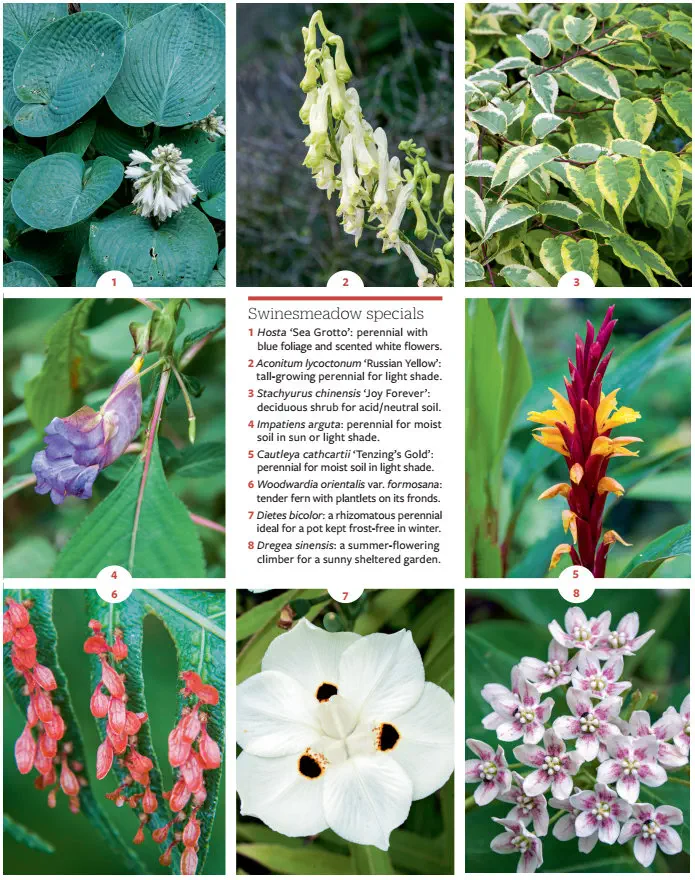
In one polytunnel I saw tempting batches of Asarum (three species), Amorphophallus konjac and a variegated Dregea sinensis as well as the more familiar green-leaved type. Like most keen plantsmen Colin is constantly on the lookout for new plants on his travels, and is quick to establish his purchases before propagating them for sale. Some 75 percent of his saleable stock are raised from ‘in house’ propagation, much of it thanks to Marcus. ‘I can never resist a good plant when I see it,’ says Colin and, like many others in this exciting, often financially precarious business, he depends on customers feeling the same.


